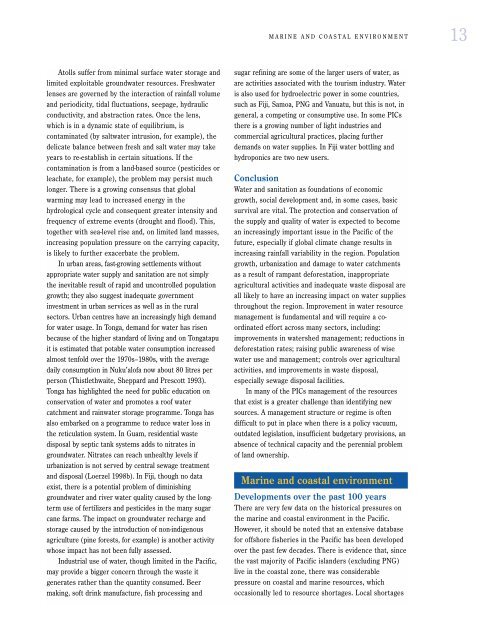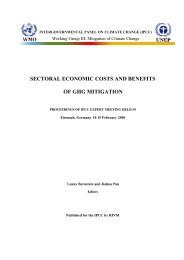Pacific Islands Environment Outlook - UNEP
Pacific Islands Environment Outlook - UNEP
Pacific Islands Environment Outlook - UNEP
You also want an ePaper? Increase the reach of your titles
YUMPU automatically turns print PDFs into web optimized ePapers that Google loves.
MARINE AND COASTAL ENVIRONMENT 13<br />
Atolls suffer from minimal surface water storage and<br />
limited exploitable groundwater resources. Freshwater<br />
lenses are governed by the interaction of rainfall volume<br />
and periodicity, tidal fluctuations, seepage, hydraulic<br />
conductivity, and abstraction rates. Once the lens,<br />
which is in a dynamic state of equilibrium, is<br />
contaminated (by saltwater intrusion, for example), the<br />
delicate balance between fresh and salt water may take<br />
years to re-establish in certain situations. If the<br />
contamination is from a land-based source (pesticides or<br />
leachate, for example), the problem may persist much<br />
longer. There is a growing consensus that global<br />
warming may lead to increased energy in the<br />
hydrological cycle and consequent greater intensity and<br />
frequency of extreme events (drought and flood). This,<br />
together with sea-level rise and, on limited land masses,<br />
increasing population pressure on the carrying capacity,<br />
is likely to further exacerbate the problem.<br />
In urban areas, fast-growing settlements without<br />
appropriate water supply and sanitation are not simply<br />
the inevitable result of rapid and uncontrolled population<br />
growth; they also suggest inadequate government<br />
investment in urban services as well as in the rural<br />
sectors. Urban centres have an increasingly high demand<br />
for water usage. In Tonga, demand for water has risen<br />
because of the higher standard of living and on Tongatapu<br />
it is estimated that potable water consumption increased<br />
almost tenfold over the 1970s–1980s, with the average<br />
daily consumption in Nuku’alofa now about 80 litres per<br />
person (Thistlethwaite, Sheppard and Prescott 1993).<br />
Tonga has highlighted the need for public education on<br />
conservation of water and promotes a roof water<br />
catchment and rainwater storage programme. Tonga has<br />
also embarked on a programme to reduce water loss in<br />
the reticulation system. In Guam, residential waste<br />
disposal by septic tank systems adds to nitrates in<br />
groundwater. Nitrates can reach unhealthy levels if<br />
urbanization is not served by central sewage treatment<br />
and disposal (Loerzel 1998b). In Fiji, though no data<br />
exist, there is a potential problem of diminishing<br />
groundwater and river water quality caused by the longterm<br />
use of fertilizers and pesticides in the many sugar<br />
cane farms. The impact on groundwater recharge and<br />
storage caused by the introduction of non-indigenous<br />
agriculture (pine forests, for example) is another activity<br />
whose impact has not been fully assessed.<br />
Industrial use of water, though limited in the <strong>Pacific</strong>,<br />
may provide a bigger concern through the waste it<br />
generates rather than the quantity consumed. Beer<br />
making, soft drink manufacture, fish processing and<br />
sugar refining are some of the larger users of water, as<br />
are activities associated with the tourism industry. Water<br />
is also used for hydroelectric power in some countries,<br />
such as Fiji, Samoa, PNG and Vanuatu, but this is not, in<br />
general, a competing or consumptive use. In some PICs<br />
there is a growing number of light industries and<br />
commercial agricultural practices, placing further<br />
demands on water supplies. In Fiji water bottling and<br />
hydroponics are two new users.<br />
Conclusion<br />
Water and sanitation as foundations of economic<br />
growth, social development and, in some cases, basic<br />
survival are vital. The protection and conservation of<br />
the supply and quality of water is expected to become<br />
an increasingly important issue in the <strong>Pacific</strong> of the<br />
future, especially if global climate change results in<br />
increasing rainfall variability in the region. Population<br />
growth, urbanization and damage to water catchments<br />
as a result of rampant deforestation, inappropriate<br />
agricultural activities and inadequate waste disposal are<br />
all likely to have an increasing impact on water supplies<br />
throughout the region. Improvement in water resource<br />
management is fundamental and will require a coordinated<br />
effort across many sectors, including:<br />
improvements in watershed management; reductions in<br />
deforestation rates; raising public awareness of wise<br />
water use and management; controls over agricultural<br />
activities, and improvements in waste disposal,<br />
especially sewage disposal facilities.<br />
In many of the PICs management of the resources<br />
that exist is a greater challenge than identifying new<br />
sources. A management structure or regime is often<br />
difficult to put in place when there is a policy vacuum,<br />
outdated legislation, insufficient budgetary provisions, an<br />
absence of technical capacity and the perennial problem<br />
of land ownership.<br />
Marine and coastal environment<br />
Developments over the past 100 years<br />
There are very few data on the historical pressures on<br />
the marine and coastal environment in the <strong>Pacific</strong>.<br />
However, it should be noted that an extensive database<br />
for offshore fisheries in the <strong>Pacific</strong> has been developed<br />
over the past few decades. There is evidence that, since<br />
the vast majority of <strong>Pacific</strong> islanders (excluding PNG)<br />
live in the coastal zone, there was considerable<br />
pressure on coastal and marine resources, which<br />
occasionally led to resource shortages. Local shortages

















